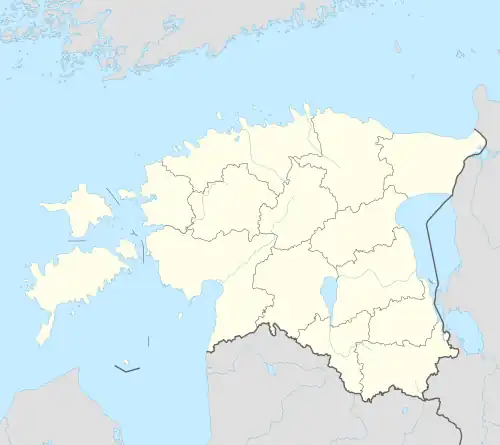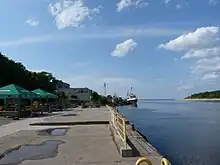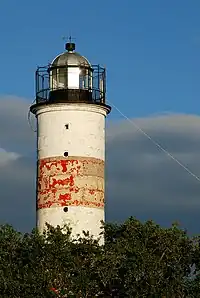Narva-Jõesuu | |
|---|---|
Town | |
 Narva-Jõesuu beach and the lighthouse | |
 Narva-Jõesuu Location in Estonia | |
| Coordinates: 59°27′32″N 28°02′26″E / 59.45889°N 28.04056°E | |
| Country | |
| County | |
| Municipality | |
| Area | |
| • Total | 11.03 km2 (4.26 sq mi) |
| Population (2020)[1] | |
| • Total | 2,681 |
| • Rank | 31st |
| • Density | 240/km2 (630/sq mi) |
| Time zone | UTC+2 (EET) |
| • Summer (DST) | UTC+3 (EEST) |
Narva-Jõesuu[lower-alpha 1][lower-alpha 2] is a seaside resort town in northeastern Estonia by the Gulf of Finland of the Baltic Sea. Administratively part of Ida-Viru County, it is located on the west bank of the Narva river which forms the Estonia-Russia international border.
The town's historical name variants in both the Estonian (Narva jõe-suu) and Russian languages (Усть-Нарова, Ust'-Narova) literally mean "mouth of Narva river".
Demographics
Narva-Jõesuu has a population of 2,681 (as of 1 January 2020).[2] As in the nearby city of Narva, most residents today are Russian or Russian-speaking, although the percentage of native Estonians is slightly higher in Narva-Jõesuu (13% compared to 4% in Narva).
History
The settlement probably arose in the 14th century, then part of the Duchy of Estonia, a dominion of the Livonian Order within Terra Mariana from 1346. It was first documented in a 1503 deed issued by Master of the Order Wolter von Plettenberg and was the site of an outer harbour of the City of Narva from the 16th century, containing several timber stockyards, sawmills, and small shipbuilding industry.
The Narva-Jõesuu Lighthouse was erected in 1808.
Thanks to its 8-kilometer (5.0 mi)-long white sand beach lined with pine trees – considered one of the finest in Estonia – Narva-Jõesuu has long been a popular summer destination. In the late 19th and early 20th century it was a spa town frequented by the nobility from Saint Petersburg, which is less than 150 km (93 mi) to the east, and from Moscow. During the Soviet period, it was visited in large numbers by residents of Saint Petersburg (then Leningrad), particularly the Soviet "apparatchiks" and intelligentsia, many of whom built a dacha (Russian: 'summer house') in Narva-Jõesuu or on the outskirts.
In the 1990s, after the restoration of Estonia's independence, Narva-Jõesuu saw few foreign visitors from Russia or elsewhere, and as a result, many hotels and guest houses went out of business. In the 21st century, the town's resort facilities have been renovated, and the number of tourists has an upward trend. However, the number of hotels is still considerably lower compared to the late 1980s.
Narva-Jõesuu marks the northeastern terminus of the E9 European Coastal Path, which runs for 5000 km (3125 miles) from Cabo de São Vicente in Portugal.
Gallery
 Ruins of Narva-Jõesuu kuursaal ("resort hall").
Ruins of Narva-Jõesuu kuursaal ("resort hall"). Pier in the mouth of Narva River.
Pier in the mouth of Narva River.
 Park in the town centre
Park in the town centre Narva-Jõesuu beach life
Narva-Jõesuu beach life
Notes
References
- ↑ Population by sex, age and place of residence after the 2017 administrative reform, 1 January. Statistics Estonia.
- ↑ "Population figure and composition". Statistics Estonia. Retrieved 24 May 2010.
